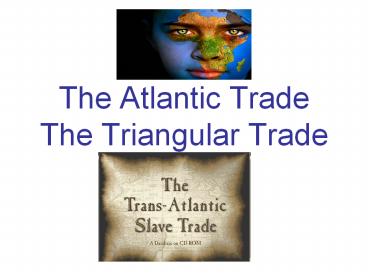The Atlantic Trade The Triangular Trade - PowerPoint PPT Presentation
Title:
The Atlantic Trade The Triangular Trade
Description:
The Atlantic Trade The Triangular Trade At the conclusion of the War of Spanish Succession, the Treaty of Utrecht gave to Great Britain a thirty-year asiento, or ... – PowerPoint PPT presentation
Number of Views:441
Avg rating:3.0/5.0
Title: The Atlantic Trade The Triangular Trade
1
The Atlantic TradeThe Triangular Trade
2
The Finished Picture
3
Definition
- Triangular Trade
- Trade routes between Africa, Europe and the
Americas during the Atlantic Slave Trade.
4
Maps of the Triangular Trade
5
Stage One Outward Passage Europe to Africa
- Ships left Europe loaded with goods, such as
guns, tools, textiles rum. - Crews with guns went ashore to capture slaves.
- Slaves were obtained by
- 1. Kidnapping
- 2. Trading
- 3. People were given by chiefs as tributes
(gifts) - 4. Chiefs would send people who were in debt
- 5. Chiefs would send criminals through
judicial - process
- 6. Prisoners of tribal wars were also sent.
6
Goree, or Slave-Stick
- A French naval officer, in the Angola region
in the late eighteenth century, describes how
slave traders used "a forked branch which opens
exactly to the size of a neck so the head can't
pass through it. The forked branch is pierced
with two holes so that an iron pin comes across
the neck of the slave . . ., so that the smallest
movement is sufficient to stop him and even to
strangle him
7
Goree, or Slave-Stick
8
(No Transcript)
9
Forced Participation
- African Chiefs did resist in the beginning
however, they needed weapons for defence. - The Europeans were too powerful therefore, any
effort to resistance was unsuccessful - If chiefs did supply slaves, they were
threatened to be taken as slaves.
10
(No Transcript)
11
- Slaves were held in prisons along the west coast
of Africa. - They were waiting to put on slaves ships.
- Those that journeyed from the interior and were
not fit for the ship were left on the shores to
die
12
Stage Two The Middle Passage - from Africa the
Americas
- Ships sailed across the Atlantic Ocean to the
Americas - The journey took 6-10 weeks
- Some Africans tried to jump ship, refused to eat
and rebelled. - Loss of a slaves life was a loss of for the
sailors. - Ships captains did not want slaves to die yet
the conditions during passage were awful and many
did.
13
(No Transcript)
14
Middle Passage Africa to Americas
- Loose packing meant that the captains would
take on board fewer slaves in hope to reduce
sickness and death. - Tight packing meant that the captains would
carry as many slaves as their ship could hold, as
they believed that many blacks would die on the
voyage anyway
15
(No Transcript)
16
(No Transcript)
17
(No Transcript)
18
Stage Three- Homeward Passage Americas to Europe
- Africans would be sold at auctions in the
Americas - The ships captains would use the from their
sale to buy a 3rd cargo of raw materials sugar,
spices or tobacco in the Americas. - They sold this for a further large profit in
Europe. - In Europe, they would convert the raw materials
into finished product.
19
Growth of Slaves in Virginia
20
Auctions
- There were 3 ways slaves were auctioned off
- Public Auctions
- - They put tar on the slaves to hide any sores
and cuts - - Slaves were inspected
- - An auction to took place and the higher bidder
would get to purchase the slave. - - Bids were taken as long as an inch of a candle
burned. - - Slaves were branded
- - Families were separated
- - They were given a European name.
21
(No Transcript)
22
(No Transcript)
23
Auctions
- 2. Private Auctions
- Similar to public auctions
- They were indoors and red markers would be placed
on the door to indicate an auction.
24
(No Transcript)
25
Auctions
- A Scramble
- They would take place on the docks or on the deck
of the ship - There would be a fixed price per head
- Slave owners would go in and grab who they wanted
to purchase.
26
(No Transcript)
27
1776 Colonies become USA
- The English colonies declared independence from
British rule in 1776 - Even though slavery was coming to the end in
England, in the new USA, slavery continued to be
permitted in the new US Constitution.
28
American Slaves in 1790
29
When did slavery end in Britain and in the United
States?
- 1807 The slave trade was abolished in the
British Empire, which meant that no slaves would
be carried from Africa in British ships. - 1838 all slaves were given complete freedom in
Britain - 1808 The slave trade was abolished in the US
which meant that no slaves would be brought to
the US from Africa. - 1865 -Slavery in the USA was abolished as the
Civil War ended with the 15th Amendment.
30
Triangular Trade
31
Read 4 Primary Sources and respond!































